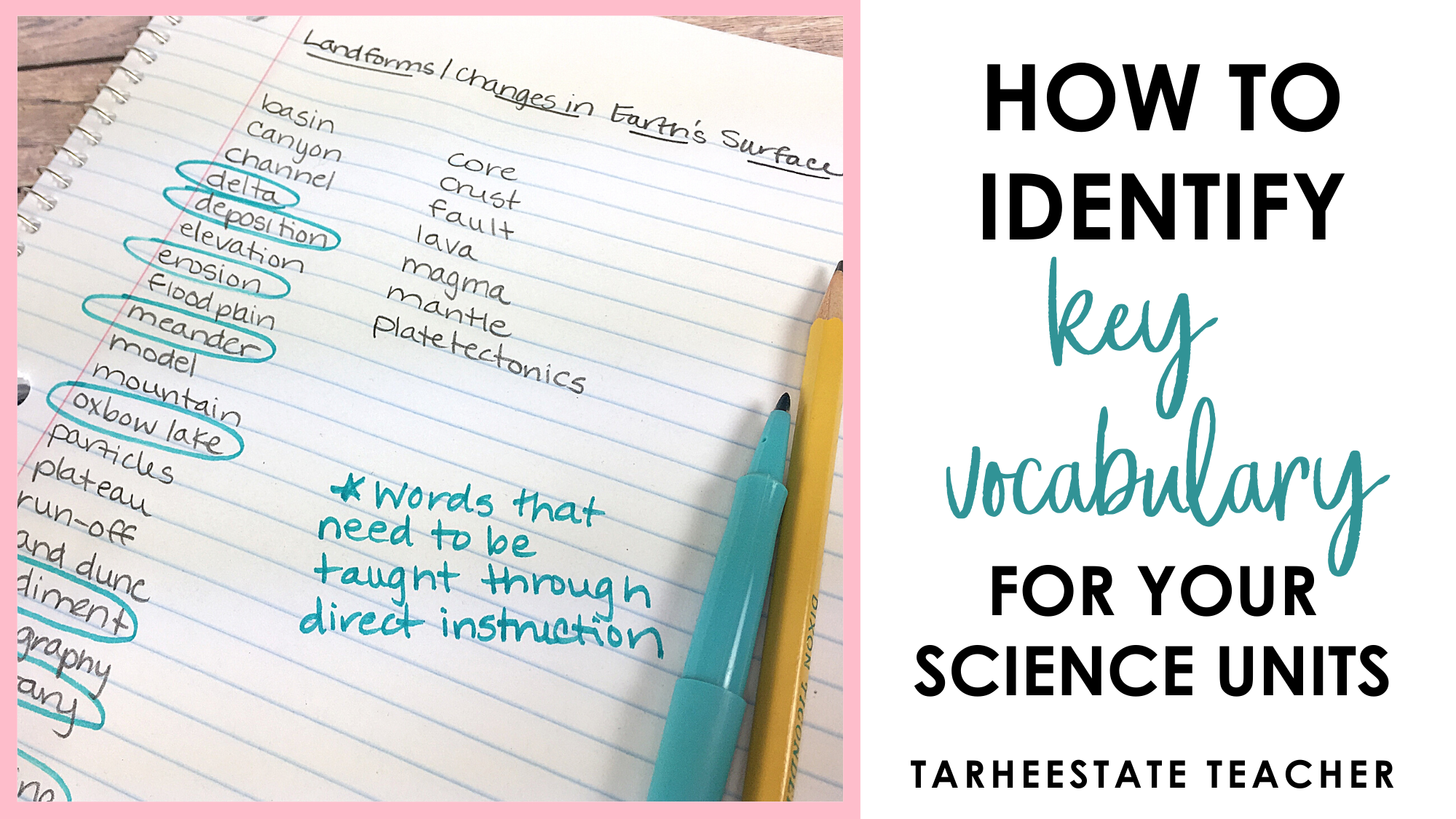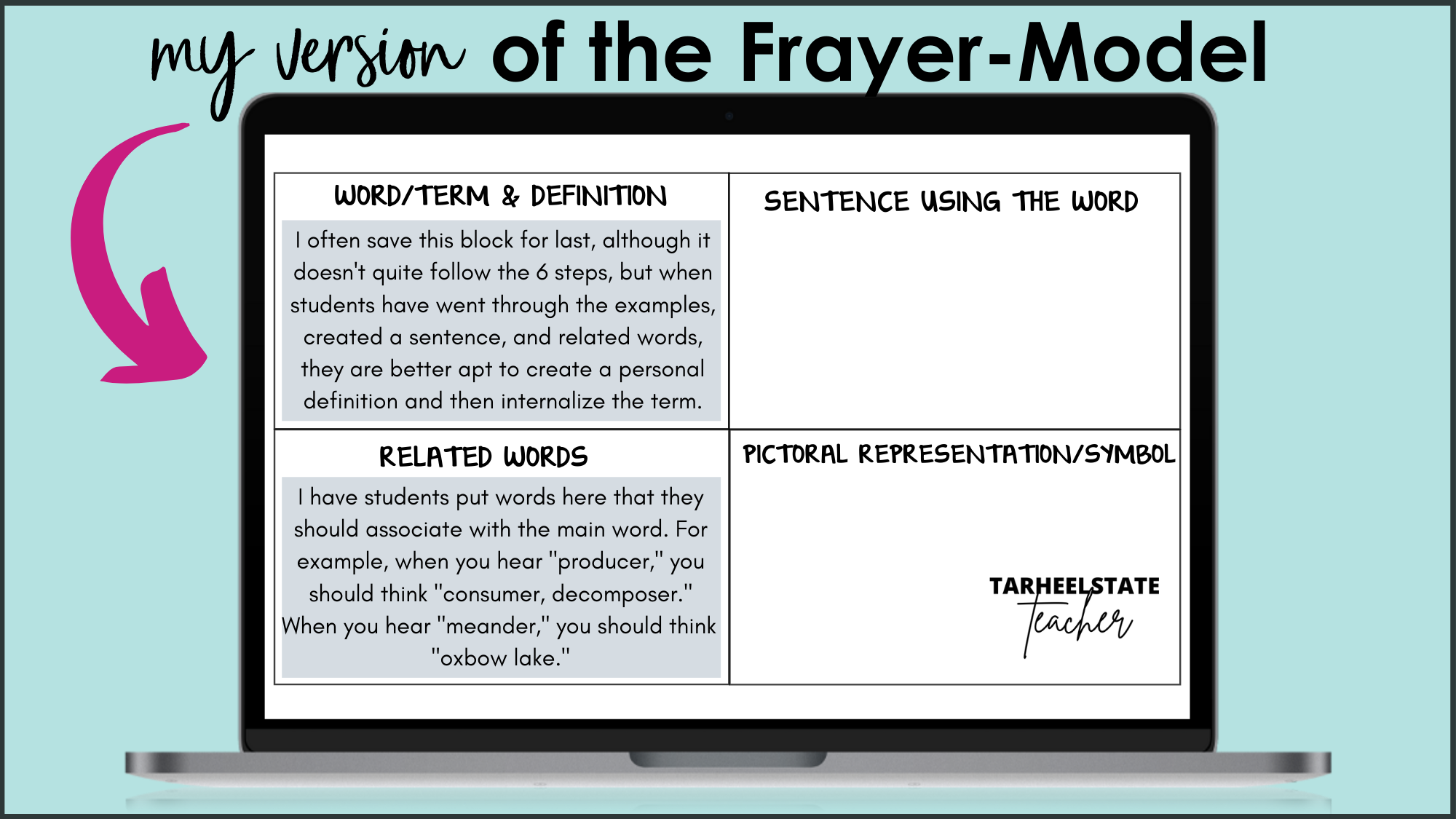How to Identify Your Tier 3 Content-Area Vocabulary Words
I believe that it is imperative that students master 80% or more of our content-specific vocabulary in order to truly master a content area and be successful in future grades.
Beck and McKeown call these content area words "tier 3 words" because they are topic-specific, are seen outside of the studies of a domain less frequently than tier 1 and 2 words, and typically need to be directly taught for students to master them.
I also believe that it is our responsibility as teachers to set aside classroom time for direct-instruction and review of content-area vocabulary. Rather than hope students learn the key vocabulary in a unit through osmosis, we can help students master vocabulary through ISOLATED vocabulary activities and direct instruction.
Today, I'm going to share with you the process my grade-level team went through to identify our tier 3 words for our Weathering and Erosion unit.
But, before we get going, let's make sure we all know WHY we need to focus (some of our) class time on vocabulary instruction.
Wouldn’t it be nice if when you were teaching ecosystems (part of your curriculum) and you talked about PRODUCERS (organisms that make their own food), all students already had mastery of the word PHOTOSYNTHESIS (since you know that this is in a previous grade’s curriculum)?
All too often, we know that many students do NOT carry these content-specific vocabulary terms with them from the previous grade-level.
In order to carry these important words with them to the next grade level, students must be afforded more than simply hearing the words in whole group instruction, seeing them in the content-area reading that they do, and having them embedded in their classroom activities.
"We talked about that last year" is simply not enough to ensure that students maintain and master these words for life.
If you still aren't sure that ISOLATED and DIRECT instruction in vocabulary is necessary, think about your students with learning disabilities, your English language learners, and your struggling readers. Heck, even your average students may appear to know what you are talking about, but may forget word meanings once the unit is over and you have moved on to something else.
If we really want students to walk away from our teaching units with mastery and ownership of the important vocabulary in our curriculum, we must directly teach for the mastery of those words.
So, where do we start?
All the words seem important.
> > > This feeling is so true! And, the overwhelm of not knowing where to start (so not getting started at all) is a habit to break ourselves from as teachers.
HOW TO IDENTIFY KEY VOCABULARY FOR A CONTENT AREA TOPIC
If your school or district does not already have a set of content-area words identified (and even if they do), you can start by creating a list of all the words you think are important and related to the unit you are teaching.
YOU CAN identify the vocabulary words that YOU think are TIER 3. You don't have to wait for someone else to deem a list of words as the "golden ticket" to vocabulary success.
The GOAL of TEACHING just about any list of words for MASTERY is enough to help children make improvements and gains.
Your list doesn't have to be perfect---but the effort to help students master those words is worth it!
Step 1: Brainstorm possible tier-3 vocabulary words
To identify our Tier 3 vocabulary words, we pulled together a number of resources—our state standards, guides from the Department of Education that support teacher understanding of the standards, a few science textbooks, a science kit, released End of Grade test questions, and unit plans. After looking through these resources, we had a long list of words that were potentially crucial for our students to master in order to understand the topic of landforms and the standards they were supposed to learn within this unit.
Our initial list is pictured:
Obviously, this list is too long for directly instructing students on each one, unless that’s all we planned to do with our science time. That brings us to step 2…
Step 2: choose the words that are critical to our curriculum
Some of the words in our above list come from extension content (like core, mantle, crust), but are not directly stated in our standards. Some words on the list were also put there in hopes that students could say “I REALLY KNOW WHAT THIS WORD MEANS” in a vocabulary knowledge activity we do on the first day of our science units. We added these words to the list because they were related to the topics of our unit and in hopes that these words would give students confidence because not all words were new to them. These words (perhaps taught in previous grade levels) would also help students attach new word learning to previously learned words.
We then noted the words that we felt were simple enough (or discussed so often) that students would learn them quickly through experiences during the unit.
"Basin" was an example of this. During this unit, students work with stream tables daily, and hold a basin under the stream table to catch the water as it comes out. (A basin is a depression in the earth that holds water; we assumed that calling their plastic water catcher a basin would suffice in helping students memorize this word).
"Canyon" was also eliminated as every group would end up with a canyon in their stream table activity. We would constantly point it out to students, show pictures of the Grand Canyon, etc. Students would master canyon through the regular activities of the unit. So, these words did not make it onto our "tier 3" list.
After asking ourselves, “Which words would we need to ENSURE students mastered AND which words might not be MASTERED by EVERY STUDENT through our normal classroom experiences? Which words need DIRECT INSTRUCTION?,” we whittled our list down to 8 words: delta, deposition, erosion, meander, oxbow lake, sediment, tributary, weathering.
We knew that it was likely that students would encounter these words on our end of grade science test. Students needed to understand the difference between weathering and erosion. We might not see a meander in our stream tables, and an oxbow lake is extremely difficult to create and capture before it is once again changed by the flow of water.
Knowing that "meander" and "oxbow lake" are tested vocabulary words, we knew we needed to take these words through Marzano's 6 steps (discussed below), show many examples, put them in review games like bingo and jeopardy, encourage students to use the terms when writing about and discussing our science activities, and review them again before testing.
Success!
Once you have trimmed your words to only the ones that will require direct-instruction, managing to set aside time to help students master these terms seems doable. We took our list from 28 words to 8 through this process!
So, how do you directly teach vocabulary to help students master these words?
Robert Marzano has researched and wrote heavily about the 6-steps of vocabulary instruction. These steps include:
1-Teacher Explains
-Provide a student-friendly definition, example, or explanation of the word. (This step can take just a few minutes).
Students should not be using precious class time to look up your content-area vocabulary words.
Ideas:
tell a story, point out a class experience that incorporated the word, show an image, describe what you think of when you hear the word, create a picture or share a video that demonstrates the word.
2-Students Restate
-Ask students to restate the explanation of the word in their own words
Students should not simply copy the teachers example, but construct their own example, description, sentence, or explanation.
3-Students Show/Represent
-Students construct a graphic representation of the word (picture, symbol, capturing a classroom experience related to the word, etc)
This non-linguistic representation helps students visualize the word and code it into their brains in a different mode than simply written or oral processing.
4-Discuss
-Use discussion activities to help students add to their knowledge of the word
Ideas: identify synonyms/antonyms of the word, create analogies, metaphors, talk with a partner, word wall games, Give 1, Get 1 activities, complete a Frayer Model with a partner, etc.
5-Refine and Reflect
-Students return to their vocabulary work (perhaps in a vocab notebook) and refine their definitions, examples, sentences, etc. Students can discuss with a partner new ideas they have about the word at the end of your lessons and activities. (Great closure activity!)
6-Practice, Play, and Maintain:
Provide opportunities for students to practice the words through games; this energizes students to review the words and helps students maintain their learning and put the words into mastery.
Steps 1-3 or 4 might all happen in the same day.
Step 5 would be appropriate after students have had time to work with the words/concepts in classroom experiences, and Step 6 is appropriate all year as you try to add more words to students memory banks.
As you are going through these steps, how and where do students record them?
Here is one option called the Frayer Model. I have probably modified it a million times over the years. It usually contains examples and nonexamples, and googling it, I think I should not be calling it the frayer model any more, but here's my template.
Marzano suggests playing learning games weekly with vocabulary words. Perhaps you set aside 15-30 minutes a week during your content areas for word-learning/review games. This would give you time to review words from a unit in isolation but to also mix them together as you study multiple units. Vocabulary Friyay's sound like a cool thing to me!
In this vocabulary mini-blog series, I've shared some of my FAVORITE vocabulary activities to get your wheels turning on how you can start infusing your classroom with content-area vocabulary learning! Check them out here:
→ The BEST Activities for Launching Science Units
→ Vocabulary Mats: My FAVORITE Science Study Strategy
→ Interactive Ideas for your Science Word Wall
If you are interested in grabbing up some of the resources now, my VOCABULARY MATS and VOCABULARY STUDY SLIPS resources are listed below:
Force, Motion, and Simple Machines
Ecosystems and Biomes/Types of Ecosystems
Properties of Rocks and Minerals
Conservation of Energy and Properties of Matter
Weathering, Erosion, and Plate Tectonics
Watch the video below to see the vocabulary mats strategy in action!

(6-Steps information from Building Background Knowledge for Academic Achievement; Marzano (2004).)





